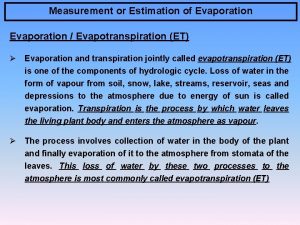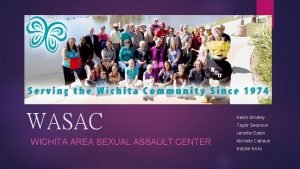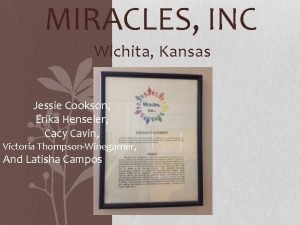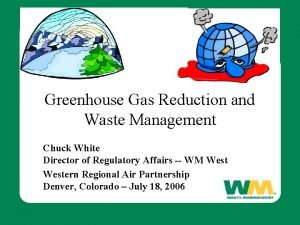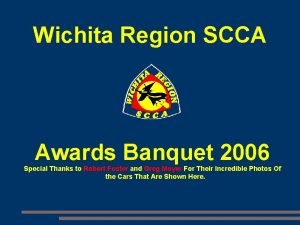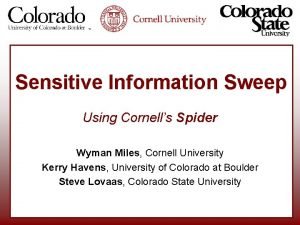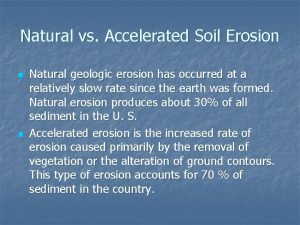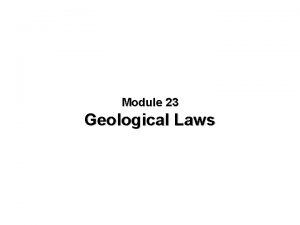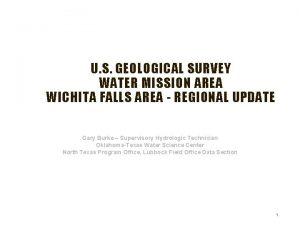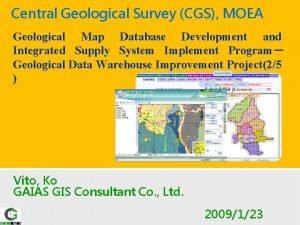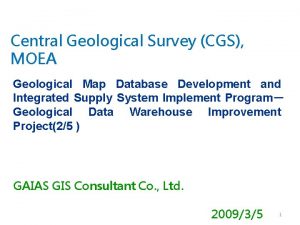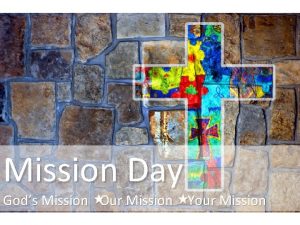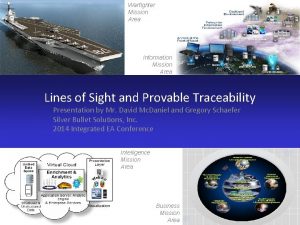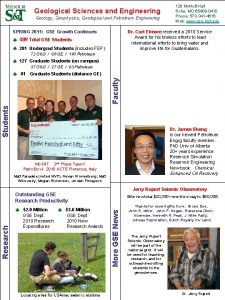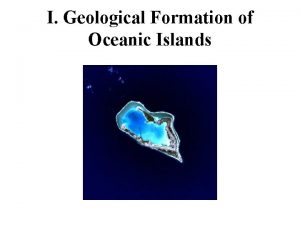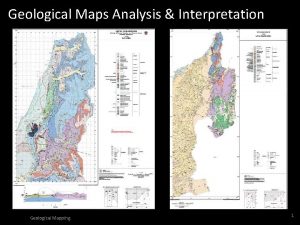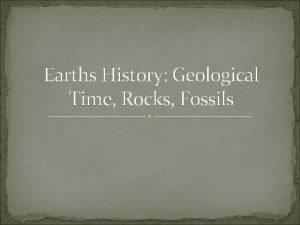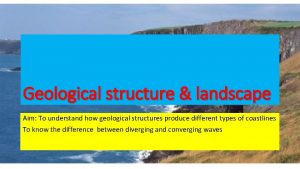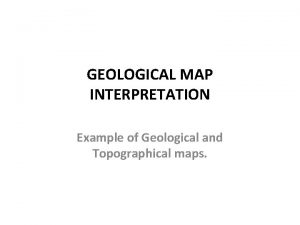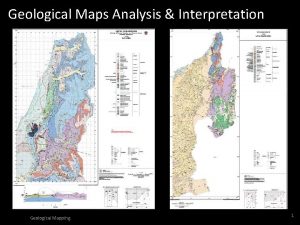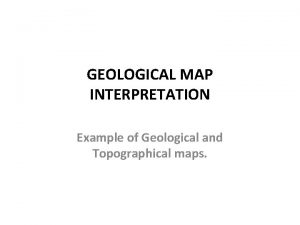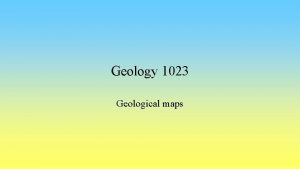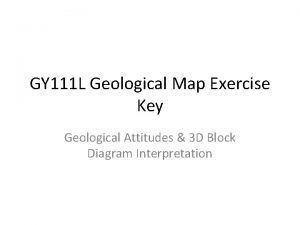U S GEOLOGICAL SURVEY WATER MISSION AREA WICHITA

















- Slides: 17

U. S. GEOLOGICAL SURVEY WATER MISSION AREA WICHITA FALLS AREA - REGIONAL UPDATE Gary Burke – Supervisory Hydrologic Technician Oklahoma-Texas Water Science Center North Texas Program Office, Lubbock Field Office Data Section 1

SUMMARY: • History & Agency Structure • Mission Statement • Congressional Initiatives and Local Cooperation • Regional Involvement 2

U. S. GEOLOGICAL SURVEY HISTORY: 3

6 DIFFERENT SCIENCE MISSION AREAS • Ecosystems • Energy, Minerals, and Environmental Health • Climate and Land. Use Change • Core Science Systems • Natural Hazards • Water 4

“To provide reliable, impartial, timely information that is needed to understand the Nation’s water resources. ” WATER AREA’S MISSION STATEMENT: Minimize the loss of life and property as a result of waterrelated natural hazards, such as floods, droughts, and land movement. Protect and enhance water resources for human health, aquatic health and environmental quality. The Survey actively promotes the use of this information by decision makers to: Effectively manage ground-water and surface-water resources for domestic, agricultural, commercial, industrial, recreational, and ecological uses. Contribute to wise physical and economic development of the Nation’s resources for the benefit of present and future generations. 5

OUR WATER SCIENCE INFORMATION: • Informs water managers – (City of Wichita Falls) • Informs civil engineers – TXDOT, USACE-Tulsa District • Monitors and models our environment – NWS Arkansas-Red Basin Forecast Center • Ensures compliance between water users – State of Texas Water Rights interests vs. State of Oklahoma Rights Interests • Used Extensively by the pubic and academia 6

CONGRESSIONAL INITIATIVES: • USGS Water has 2 line items in budget: – Water Resources Availability Program (WRAP); The USGS Water Resources Availability Program (WRAP) fulfills the goals established by Congress in the SECURE Water Act (Public Law (P. L. ) 111 -11, Section 9508) by investing in research and assessments that improve the Nation’s understanding of water availability. – Water Observing Systems (WOSP); Monitoring networks that generate data on the quantity and quality of the Nation’s water resources are the foundation for situational awareness and understanding the Nation’s water resources. The Water Observing Systems Program (WOSP) encompasses the Water Resources Mission Area’s objectives to collect, manage, and disseminate consistently high-quality and reliable water information in real-time and over the long term, both of which are critical for managing the Nation’s water resources and anticipating and responding to water hazards that can result in loss of life and property. 7

LOCAL COOPERATION Cooperative Matching Fund Programs; Cooperators in the Lubbock Field Office Data Program in the Red Basin: Our programs are not 100% congressionally funded Texas Water Development Board Drive our science in Water Science Centers USACE-Tulsa District Allow us to work with State and local cooperators on their program science needs City of Wichita Falls Wichita County Water Improvement District Tarrant Regional Water District Greenbelt Municipal & Industrial Water Authority 8

LOCAL USGS STRUCTURE: • Oklahoma-Texas Water Science Center – North Texas Program Branch; – managed out of Fort Worth • Lubbock Data Section; – Wichita Falls Field Office (partnered & located with MSU) – Lubbock Field Office 9

NEW RECENT LOCAL REORGANIZATIONS • Used to be a Texas Water Science Center and an Oklahoma Water Science Center; (Merged October 2019) • The Lubbock Field Office is new (Fall 2018) • Our presence on campus at Midwestern State University is new (Summer 2019) 10

DATA PROGRAM:

DATA PRODUCTS: • NWIS • Water Alert • Water Watch • National Water Census • TX Water Dashboard 12

Red River Focus Area Study Zebra Mussel Monitoring Harmful Algal Bloom ONGOING STUDIES:

RED RIVER FOCUS AREA STUDY • The USGS is undertaking a 4 -year study of water use, availability, and change in the Red River basin in one of several national “Focus Area Studies” in the Department of Interior’s Water. SMART initiative. – Water Use – Groundwater Flow Model – Rain-Runoff Model – Ecological Response Modeling 14

ZEBRA MUSSELS: • Currently monitoring Lake Texoma, Greenbelt Lake in the Red River Basin • Established populations in: – Lake Texoma since 2009 – Red River downstream of Lake Texoma since 2009 – Lake Murray since 2012. – Lake Waurika since 2017. • DNA has been detected in Lake Kemp and Greenbelt Reservoir. 15

HARMFUL ALGAL BLOOMS: • • • Lakes Surveyed; Lakes Texoma, Kemp, Arrowhead, Pat Mayse Results in 2016 - Cyanobacteria and green algae were detected at all surveyed reservoirs. – LAKE KEMP: Cylindrospermopsin (hepatotoxin) and saxitoxin (neurotoxin) were detected at low levels. – LAKE ARROWHEAD: There was a very high concentration of MIB. Results in 2018/2019 - Cyanobacteria and green algae were detected at all surveyed reservoirs. – LAKE KEMP: Cylindrospermopsin (hepatotoxin) and saxitoxin (neurotoxin) were detected at low levels. There was a high concentration of genes that encode cylindrospermopsin. – LAKE TEXOMA: There was a moderate concentration of genes that encode microcystin (hepatotoxin) and a low concentration of genes that encode cylindrospermopsin. – PAT MAYSE LAKE: There was a low concentration of genes that encode anatoxin (neurotoxin). 16

THANK YOU GFBURKE@USGS. GOV 17
 Us geological survey floating pan
Us geological survey floating pan Wasac
Wasac Water and water and water water
Water and water and water water Miracles inc wichita ks
Miracles inc wichita ks Waste management (now wm) - wichita hauling
Waste management (now wm) - wichita hauling Wichita avaya
Wichita avaya Wichita scca
Wichita scca Cornell spider
Cornell spider Support through sustainability wichita
Support through sustainability wichita Volejbal vznik
Volejbal vznik Ups wichita ks
Ups wichita ks Wsu outlook
Wsu outlook Klothes kloset wichita ks
Klothes kloset wichita ks 叫叫abcd
叫叫abcd Continental drift theory and plate tectonics theory
Continental drift theory and plate tectonics theory Roman architecture influence
Roman architecture influence Differentiate between geological and accelerated erosion
Differentiate between geological and accelerated erosion Geological laws
Geological laws
